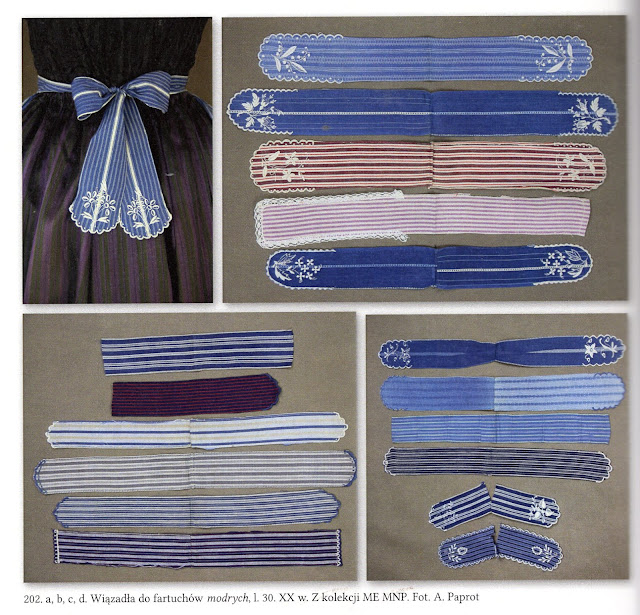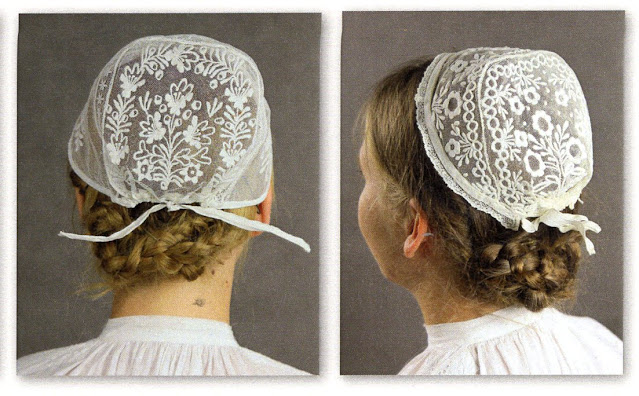Hello all,
Today I would like to examine another Town Costume from Poland, that of the city of Poznan' and surrounding area, called the Bamberk Costume.
In the years following The Great Northern War and its subsequent Cholera epidemic, Several villages around the city of Poznan' became depopulated. The local authorities appealed to German peasants around the City of Bamberg to come and help resettle. The only condition made was that they be Catholic. Approximately 500 settlers came, starting in 1719. They received land and dwellings, and soon assimilated into the surrounding population. They are still called Bamberky, however, and developed their own distinctive attire, based on the dress of Wielkopolska rather than that of Germany.
https://en.wikipedia.org/wiki/Bambers
The Bamber villages have mostly been incorporated in Poznan' today. Here is a map of the city, the original Bamber villages, and the portion of the city that identifies with this attire.
Here is the location of Poznan' within Poland.
The Bamber people, while acknowledging their German heritage, today consider themselves to be Polish, and speak only the Polish Language.
The image at the head of the article shows the festive costume traditionally worn by unmarried girls.
Foundation garments consisted of camisole and bloomers.
A shirt, koszula, was worn over the camisole. It varied in quality according to the occasion. For dress it is of fine linen with cutwork embroidery on the cuffs and collar.
In more recent times the shirt is made of bought cloth.
Over the shirt was worn a vest or detached bodice called Snzurówka. This was worn for work, or around the house. It might also be worn as an outer garment by girls or young women in summer for relatively informal occasions. In this case, it was required to be of a contrasting color to the skirt. It was sometimes laced shut, and, in spite of the name, was sometimes buttoned. A padded roll may be added to the waist, all around, or just in back. This was called a kiszka, and served to help hold up the skirt and add fullness to the hips.
Usually, when going out, and especially for dress occasions, a short jacket, kaftun, was worn. These reached only to the waist, and were made of diverse materials appropriate to the occasion. They were lightweight in summer, and of heavier cloth in winter.
They were constructed with a princess line cut in the back, with or without a center seam. They might have a short peplum. The upper sleeve was full, and they tapered towards the wrist. They were lined, often boned in front, and had much variety in color, pattern, and placement of ruched ribbon and other ornament.
These garments obviously added to the much desired fullness of the skirt. My sources do not talk about the origin of these garments, but the only other place that I know of where such quilted underskirts are worn is Provence.
The skirt itself, Suknia, was either gathered into a waistband or had a drawstring. It was very full and made of rich materials for dress or more utilitarian cloth for everyday. They are unadorned.
Aprons, Fartuchy, were always worn. They were gathered into a waistband, and had decorative bands that tied in back. Some were made of indigo, with white stripes, and possibly floral embroidery as well.
Another development was to put grosgrain ribbon on the corners, and use them to fasten the apron in place, and then take a decorative length of cloth and hang it over the ribbon in back. This can be seen in these everyday aprons.
This was also sometimes done for the indigo aprons. These are called Wiązadła, and could feature cutwork embroidery.
Dress outfits often used fine batiste aprons with machine or hand embroidered cutwork. Voile was also sometimes used.
Wiązadła of damask or brocade would accompany these aprons.
And then, of course, the craze for tulle took over and pushed everything else out for dress outfits. I personally find this unfortunate.
Tulle aprons required tulle wiązadła.
Probably starting with the general European shawl fashion of the mid 1800s, Shoulder shawls of batiste or tulle matching the apron became necessary for the dress outfit. Matching handkerchiefs were held in the hands.
Here are three women dressed for the highest occasion, with batiste shawls and aprons that completely cover the skirts.
The most common dress form seen today. As these are most often worn for Church Holidays, each woman is expected to have a minimum of 4 outfits in the Liturgical colors of red, green, blue, and white/gold.
The more everyday form of the outfit has retained the older form without the shoulder shawl.
Unmarried girls wore their hair in braids.
Married women would put their hair up and cover it with a small cap, kapka or czepek. This cap would be of plain linen with a minimum of ornament for everyday. Or of embroidered tulle or batiste for more dressy occasions.
When going to market, etc. a straw sunbonnet shaped like a hood, kosziczek or budka, was worn over the czepek. This was tied under the chin with a ribbon, and for going out was made of fine straw.
The last set of photos shows the sunbonnet worn over the dress ribbons, which I find unlikely.
This headgear, to my knowledge, is unknown elsewhere in Poland, but was very popular in The Netherlands, as in this example from Walcheren.
For working in the fields, the sunbonnet was made of coarser straw, and shaped more with an eye for protection from the sun, rather than presentation, thus resembling bonnets from places like Spain.
For the dressiest occasions, married women have two options. The one more commonly seen today is the dress czepek from above with four wide Wiązadła attached to the sides and rear.
The two at the sides would be tied in a bow under the chin, and the two in back would be tied in a large bow in place, with the ends hanging down.
A brightly colored silk scarf, jedwabnica, would be rolled up and placed around the edge of the czepek.
Kashmiri shawls were often folded and placed over this headgear for cooler weather or more dressy occasions. These were not produced locally, but imported, at first from Kashmir, and later from European textile centers, as they were in other parts of Europe, when they became all the rage in the mid 1800s.
The other most dressy headgear for married women was the gold cap, czopka złotolita, found also in Silesia and Kashubia, as well as parts of Germany. This is less commonly seen today. This cap has basically the same cut as the czepek, but is made of opaque material, lined, and ornamented with gold damask, lace, and/or embroidery. These would also have 4 wiązadła, made of satin or damask, and less showy, so as to show off the gold.

The most distinctive headdress of this region is the kornet, worn by unmarried girls on the most important ritual occasions. This was originally worn only for the procession on Corpus Christi, but has spread to other important Liturgical holidays, Weddings, and is worn more and more commonly today, without regard to traditional rules.
This headdress has a cardboard and wire base, covered with cloth and laced up the back. The front is covered with artificial flowers, and the back with loops of ribbon. A large bow is attached at the rear bottom. The height of the kornet varies somewhat.
Separate frilled collars, fryzki, were worn around the neck.
As well as crosses and coral and amber necklaces. Necklaces often had wide ribbons, wstiążki, tied in a bow and attached at the rear.
Loose pockets are worn under the apron. For everyday, or when wearing an opaque apron, they were made of scraps of fabric that were on hand.
With the advent of tulle aprons, the pockets began to be ornamented with beadwork or cross stitch.
Fine knitted stockings were worn, as well as high black leather shoes.
Gloves are worn in cold weather, and fine white gloves were always worn to church, in part to avoid staining the prayer books. The men have not retained a distinctive costume. What is seen these days is a rather generic Wielkopolska outfit consisting of white linen shirt, black pants and boots or shoes, double breasted red vest and long black frock coat.
Thank you for reading, I hope you have found this to be interesting and informative. This is yet another example of the creativity of humanity.
email: rkozakand@aol.com
Source Material:
Joanna Minksztym, 'Stroj Bamberski, APSL vol 47', Wroclaw, 2015
Iwona Rosin'ska et al. 'Suknia Wydaje Ludzkie Obyczaje - Wielkopolskie Stroje Ludowe', Poznan', 2005
Anna Plenzler, "Sladami Bambrow', Poznan', 2019
Stanislaw Gadomski, 'Stroj Ludowe w Polsce', Warszawa
Barbara Bazielich, 'Stroj Ludowe w Polsce - Opisy i Wykroje', 1997








































































.jfif)




















.jfif)
.jfif)
.jfif)
































.jfif)




.jfif)



Fabulous that they have evolved such a distinctive ensemble - the quilted petticoats are especially interesting (and warm!). I agree with you about the tulle - it does rather take over but it is easier and faster to work than the whitework that went before. It must be fun to see a crowd in a good stiff wind - like a cloud of very colorful butterflies with all those ribbons fluttering. Thank you for another lovely post. Charlotte in California
ReplyDeleteThis comment has been removed by a blog administrator.
ReplyDeletevery fantastic job.
ReplyDeleteHello, I found your blog in 2019 through Ukrainian embroidery and I would like to thank you for your great work throughout these years. Cheers.
ReplyDeleteThank you very much
DeleteAn outstanding post! This guide gives me all the info, I appreciate you.
ReplyDeletevery lovely
ReplyDelete